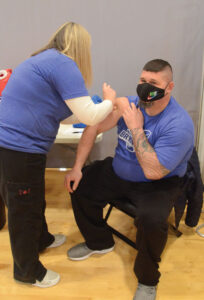 By Steve Brawner
By Steve Brawner
© 2021 by Steve Brawner Communications, Inc.
Bryant High School wrestling coach Shane Clancy did not wrestle with his decision to be vaccinated for COVID-19. After his big right arm was stuck with a small needle at the River Center gym in Benton Feb. 13, he explained, “I’m ready to ditch the mask and just be normal.”
Clancy was one of 1,200 teachers and staff members from five area school districts who received their second and final shots at a mass clinic organized by six local pharmacies.
Among the others was John Goff, a junior high math teacher who’s at increased risk as a diabetic. Goff said this has been the most stressful year of his teaching career. In addition to his health concerns, teaching quarantined students online has been challenging. It’s particularly difficult for a math teacher who needs to see a face light up when a student understands a concept, and who needs to see the sheet of paper as the student works through a problem.
The take rate for Bryant school personnel was close to 70%, Dr. Karen Walters, the district’s superintendent, told me.
Walters said vaccine decliners gave a variety of reasons. A couple of employees expressed concerns about unforeseen side effects and said they were willing to take their chances after seeing others infected by the disease suffer only moderate symptoms.
The logic is understandable, but let’s look at the numbers. The Centers for Disease Control and Prevention found 21 cases of severe anaphylactic allergic reactions among the initial 1.9 million doses of the Pfizer-BioNTech vaccine given through Dec. 23, 2020. That’s 11.1 cases for every million doses. All 21 recovered.
Bryant Family Pharmacy owner Jon Martin, who helped organize the mass vaccination, told me he has personally administered 300-500 shots while his pharmacy has administered thousands. Mild side effects are common, but no one has had a severe reaction.
Compare that to estimates that 487,926 Americans including 5,287 Arkansans have died from or with COVID as of Tuesday. If you accept those numbers – and I know not everyone does, and admittedly they’re not perfect – that’s one out of roughly 677 Americans and one out of 567 Arkansans who’ve died within the past year where COVID was at least a contributing factor.
Even if those numbers are inflated – and on the other hand, they could be too low – you’re taking a much bigger chance that you’ll die from COVID, or pass it on to someone else who does, than that you’ll suffer a severe reaction to the vaccine.
What about long-term risks? People have been getting COVID shots for a while counting the testing process, and so far there haven’t been issues. But we know there are long-term health problems associated with getting COVID, even when a patient survives the initial sickness.
Even before this bout of wintry weather, COVID cases in Arkansas were falling from their high point reached during and after the holidays. The numbers are still high, but they’re better.
Supposedly, 70-85% of the population must be immune before we reach herd immunity, where the virus has nowhere to go. The CDC says 11.4% of the state’s population has had at least one vaccine dose. Additionally, about 300,000 Arkansans have recovered from the disease and should have some immunity. That’s about 10%. Some of those numbers overlap. Many people have had the disease but were never tested. Some people already were immune to it.
Are we close? We’re at least getting closer. Regardless of where we are in the timeline, we must try to reach 70% before mutations create variants that are resistant to the vaccines and our bodies’ defenses.
It’s a race. It’s also a wrestling match against trillions of microscopic opponents. Like Shane Clancy, we’re all ready to win, ditch these masks and the other steps we’ve been taking, and just be normal – whatever the new normal will be.